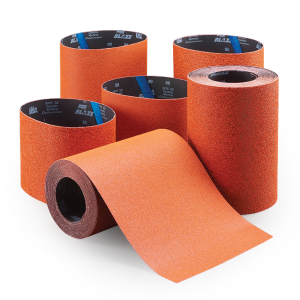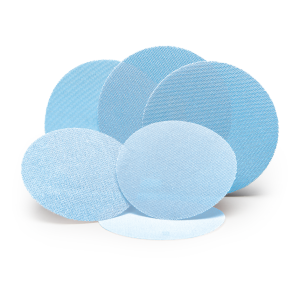Watch our Pro Shop Talk about ceramic grain sandpaper with Pat Parker, Norton Abrasives. Get all the details about Norton Mesh Power and Norton Blaze.
Recently, our technical director, Daniel Elbrecht, worked with a contractor who had trouble blending the edge of a floor to the field. The contractor used one type of sandpaper in the main area of the floor and a different type around the edge.
And that’s what caused his problem – using two different sandpaper grains on the same floor. While you may be able to use different papers on different areas, you can have issues blending the areas together.
Ultimately this will affect the smoothness, flatness and look of the floor. Using the same sandpaper grain for the edge and for the field is the key to getting the best-looking floor.
We’re all creatures of habit, whether it’s personal life or professional life. We habitually do things the same way every time.
This is especially true when it comes to sanding hardwood floors. You may not realize that there is new technology that can truly change everything. From the way you work, the quality of your work, to how long your job can take.
We talked with Pat Parker, Norton Abrasives, about what they’re doing to help save time and improve sanding with their ceramic grain sandpaper. While ceramic grain sandpaper has been around for almost 20 years, many floor guys are still using traditional sandpaper.
Keep reading to find out why ceramic grain sandpaper can change the way you sand – for the better!
Why Ceramic Grain Sandpaper Can Save You Time and Money
We’ve all seen the advances in wood flooring technology – like equipment, finishes, and penetrating oils as examples.
While many floor guys have adopted these new products, many don’t take a hard look at the sanding process. If you’re using an older type of sandpaper, you could be missing out on the benefits of your newer products. The performance of your high-tech machine or finish could be held back by your old sandpaper.
Norton manufactures sandpaper that can be used on every wood floor sanding machine. The edger, sander, multi-head, palm sander – all can be used with 100% ceramic grain technology. This gives contractors finer scratch patterns, longer lasting paper, and better cut rate.
Pat uses the analogy of carbide aluminum oxide being like a flip phone. It still works today, but it is not the most efficient product out there. Ceramic sandpapers are more like the latest iPhone. You get a lot more advantages because of the new technology in it.
With 100% ceramic sandpaper, you will have a far more consistent and minimal scratch in the floor than traditional or ceramic blend sandpapers. Ceramic blend papers combine ceramic grain with a lesser grain silicon carbide or aluminum oxide. The benefits of ceramic are a trifecta of sorts: cut rate, longevity, and scratch pattern.
Why are installers switching to ceramic grain sandpaper?
In Norton’s perspective, once contractors try their workhorse product, Red Heat, they can see the difference and want to make it their system.
This is their fastest growing category of sandpaper, especially with the growing popularity of multi-head equipment. Norton supplies every type of paper for any type of floor sanding equipment, from belts to hook and loop discs.
What type of installations are ceramic sandpaper good for?
Each family of Norton’s sandpaper has a different grain pattern for different applications. We are going to focus on Norton’s Blaze Plus, Blaze X, and Mesh Power products.
Here’s an overview of what each type is best for:
Red Heat – Finest scratch pattern for everyday sanding use; available for all machines
Blaze, Blaze Plus and Blaze X – Most aggressive abrasive for floors that have years of build-up, like a sports floor or manufactured prefinished floors; available for all machines
Mesh Power – Powerful dust extraction and fine scratch; available for multi-head machines and palm sanders

Norton Abrasives Blaze X and Blaze Plus Sandpaper
Norton Abrasives Blaze sandpaper was designed primarily for use in the sports flooring industry to cut through years of finish build-up. It has also been popular in residential use on prefinished or wood floors with tough polyurethane finish.
Also in the Norton Blaze line-up are Blaze Plus and Blaze X, both designed for use on prefinished floors. They are bit higher price point than other papers, but on a pre-finished floor you can spend days getting off an old manufactured finish. That’s a lot of money that you’re wasting labor and time – which is where Blaze X and Blaze Plus really can shine.
Blaze’s ceramic grain attacks hard finishes like aluminum oxide and leaves a consistent scratch. You’ll pay more when purchasing the sandpaper, but you’ll make up that money by spending less time sanding the floor. The consistent scratch also means that you’ll have a good looking floor without spending as much time blending in the scratches.

Norton Abrasives Mesh Power
Targeted for multi-head machine and palm sanders, Norton Mesh Power is another 100% ceramic grain powerhouse with longevity and a uniquely fine scratch.
Norton saw the need as the multi-head market continued to grow for a finer grit, above 120 in a hook and loop. You can tell by holding a Mesh Power disc that it’s not your average screen. It’s hook and loop on one side, but it’s much more flexible.
Norton calls it a soft aggressive. It’s similar to a sand dollar where you can be aggressive but put minimal scratches in the floor. Additionally, it sands well around the perimeter of a floor or for inner-coat abrasion during the finishing process. Pat also said that some installers can finish with 80 or 100 grit Mesh Power without any large, visible scratches.
Recommended Sanding Process For Ceramic Sandpaper
We asked Pat about his recommendations for sanding with Norton’s ceramic sandpaper:
“You always want to start with the finest grit possible to get the product off. Because it’s all about less scratches that you’re putting in the floor. So with products like Red Heat and Blaze, you have the ability to start much finer on a on a re-sand.
“For example, many contractors, the standard process is 36-50-80 grit or maybe even starting with 24 grit. With the ceramics you can start much finer, like many people who start at 40 and 50 for their first cut on a re-sand.
“For a new install, you can start even finer. Many guys that use red heat will start with a 60 grit for their first cut, so it saves you a lot of time – and as we know in this business time is money. It’s all about starting fine if at all possible.”
It may seem counterintuitive that you’re getting a better cut with the ceramic, but you’re also leaving finer scratches.
Instead of thinking about putting an aggressive grit on the machine to cut more floor, ceramic sandpaper allows you to start with a finer grit and get the same – if not better – cut rate.
Norton manufactures the ceramic products to fracture or to break in very small pieces. The scratch stays more consistent than traditional sandpaper. Because of that, when you get to our finer grits, you’re not “chasing that scratch.”
As Pat says, “For super flat floors that are the majority, you have to be on point with your sanding process. The better-quality abrasive you use, it truly does make your life a little bit easier at the end of the day.”
Can you skip grits with ceramic sandpaper?
You should never skip more than one grit. For example, 36-50-80 is the National Wood Flooring Association standard for a three-cut system. It doesn’t necessarily have to be 36-50-80, it can be 24 grit, but you can’t go from 24 all the way to 60. Be diligent about not skipping more than one grit, especially on older grains but also with ceramic grains.
When you really think about abrasives, it’s pretty rudimentary. Think of coarse grits as big rocks and fine grits as little rocks.
You cannot get scratches from a 36 grit with an 80 grit. A lot of micro scratches will appear, and it’s magnified depending upon the color that you’re putting on the floor, especially dark colors. Instead of going 36 grit and 80 grit, you can use 50 grit then 80 to get a much better-looking floor, without adding a step to the sanding process.
Try Norton’s Ceramic Grain Sandpaper
Give us a call at your nearest Master’s Craft to try this sandpaper! We’ll put you in touch with your Norton Abrasives rep who can walk you through everything you need to know about switching to ceramic grain sandpaper.

